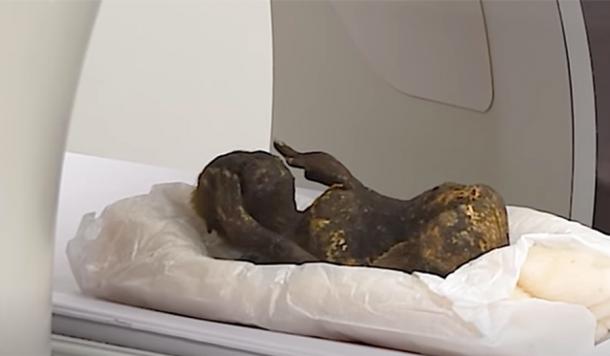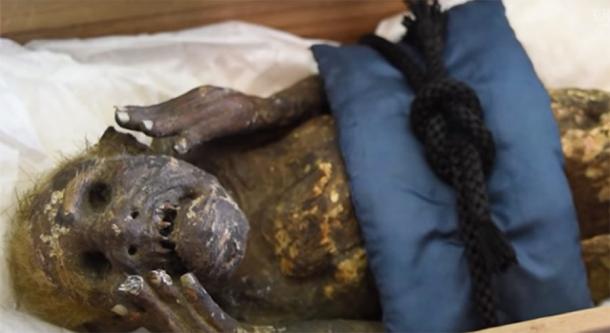
Mummified “Mermaid” CT Scanned by Japanese Scientists
The origins of a bizarre creature that resides in a Japanese temple are being studied. While the so-called mermaid is worshipped as such, a folklorist suspects this is another P. T. Barnum special.
Mermaids: The Body Found was a wildly successful 2012 mockumentary television program presented as a factual documentary on American TV channels Animal Planet and Discovery Channel. Telling the story of a faux-scientific team's investigation into the idea that mermaids are real, millions of people tuned into this show representing Animal Planet's largest audiences ever.
Now, a 300-year-old mummified “mermaid” is making headlines in Japan. The bizarre looking 12-inch (30.48 cm) creature was ‘caught’ between 1736 and 1741 in the Pacific Ocean, off the Japanese island of Shikoku. Now kept in a temple in the city of Asakuchi, the creature’s top half features a hairy head with a twisted face and pointed teeth, but its hands dangle around a fish-like lower body.

The mummified ‘mermaid’ being CT scanned in Japan. (The Asahi Shimbun Company / YouTube)
A Mummified Mermaid Offering Both Longevity and Bad Luck
To understand more about the creature’s origins, a team of scientists from Kurashiki University of Science and the Arts, a private university in Kurashiki, Okayama, Japan, CT scanned the body. According to a report in The Independant, “the bizarre creature could have religious significance,” claims Hiroshi Kinoshita of the Okayama Folklore Society who masterminded the new research project.
- Why We Can’t Resist the Lure of Mermaids
- The Fiji Mermaid: What Was the Abominable Creature and Why Was It So Popular?
In Japanese mythology mermaids are associated with immortality. The Japanese folklorist explained that ancient legends include the story of Yao-Bikuni and Ningyo (human fish or mermaid). In this myth a fisherman from Wakasa Province caught an unusual fish and the daughter of a man who forgot to throw the evil fish away “lived to 800 years old.” Ningyo was described with shining golden scales and a monkey's mouth, offering longevity to those who ate of its flesh. But the act of hunting and catching a ningyo was believed to bring storms and bad luck.
An ancient mummified ‘mermaid’ that supposedly grants immortality to anyone that tastes its flesh is to be examined by scientists
Why though? https://t.co/AfNUKKiV31
— Metro (@MetroUK) March 4, 2022
The Story of the Mummified Mermaid
The so-called “mermaid” was allegedly caught in a fish-catching net in the sea off Kochi Prefecture, according to a letter dated to 1903 that was written by one of the creature's former owners. This missive was found alongside the mummified creature in the Enjuin temple in Asakuchi, but the researchers still don’t have a clue when or how the “thing” got to the holy site. “I heard that some people, believing in the legend, used to eat the scales of mermaid mummies,” explained Hiroshi Kinoshita.
The New York Post reported that “chief priest, Kozen Kuida” from the Enjuin temple said the oddity was put on display in a glass case some 40 years ago and is now kept inside a fireproof safe. Alarmingly, the priest told The Asahi Shimbun, a Japanese newspaper, “we have worshipped it [the mermaid] hoping that it would help alleviate the coronavirus pandemic even if only slightly.” Who needs a mask and social distance when mermaid scales would do?

The mummified mermaid being CT scanned in Japan. (The Asahi Shimbun Company / YouTube)
“Give Em What They Want,” Said America’s Famous Mermaid Hoaxer
“Of course, I don’t think it’s a real mermaid,” Hiroshi Kinoshita was quick to tell the press. The folklorist reminds that legends of mermaids were popular all over the world. He concluded that the so-called mermaid was probably manufactured at some point during the Japanese Edo period between 1603 to 1867, from parts of “living animals.” It is expected that the CT scans and DNA testing will show that it was made “for export to Europe, or for spectacles in Japan.”
The Japanese scientists examining the mummified mermaid will publish their findings later this year, but it’s expected that the organic composition will be similar to the “mermaid” exhibited by P. T. Barnum in the mid 19th century at his American Museum in New York. Supposedly caught off the coast of Fiji, and later sold into America by Japanese sailors, Barnum stitched the head and body of a monkey onto the back of a fish. However, what’s interesting in both fake mermaid accounts is that they each have mythological Japanese origins stemming back to the legendary Ningyo.
Top image: Mermaid image with inset image of the Japanese mummified mermaid. Source: yukinya / Adobe Stock and Asahi Shumbun Company / Youtube
By Ashley Cowie
















Comments
Do you even READ your own article??
Quote:
“..the so-called mermaid was probably manufactured… “for export to Europe, or for spectacles in Japan.”
..and then..
“Supposedly caught off the coast of Fiji, and later sold into America by Japanese sailors”
..followed immediately by..
“Barnum stitched the head and body of a monkey onto the back of a fish.”
..Yeah, sure he did. FYI.. P.T. Barnum paid INSANE amounts of money for actual cryptozoological animals. This must have been one HELLUVA good forgery for him to have bought it and put it on display. Go read about the actual Bigfoot he purchased which was later kidnapped by government agents. ;)
The top part looks like a Japanese makaque to me.
Jamie R